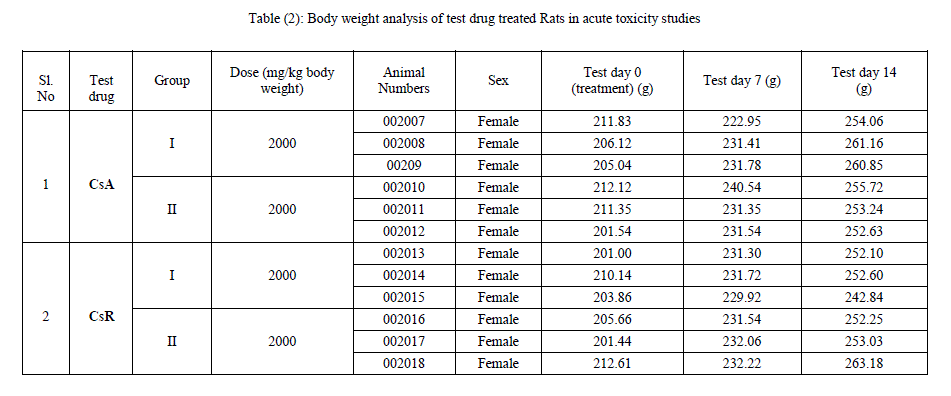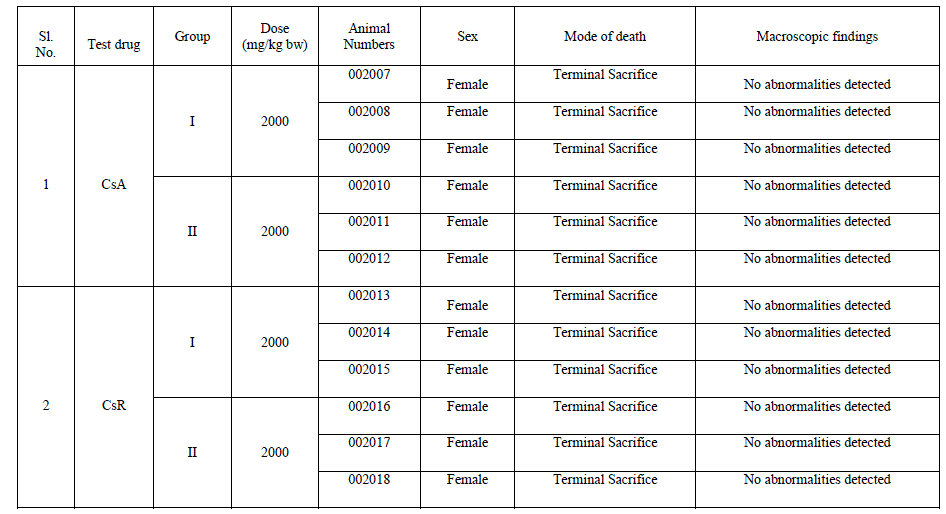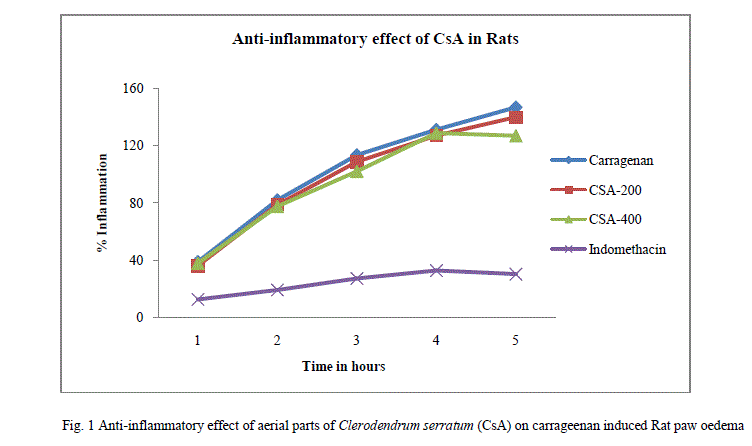ISSN ONLINE(2319-8753)PRINT(2347-6710)
ISSN ONLINE(2319-8753)PRINT(2347-6710)
Ismail Shareef. M1*, Leelavathi. S2, Gopinath. S. M.1
|
| Related article at Pubmed, Scholar Google |
Visit for more related articles at International Journal of Innovative Research in Science, Engineering and Technology
The aim of the present investigation was to evaluate the anti-rheumatic properties of methanolic extracts of the aerial parts and roots of the plant Clerodendrum serratum L. (Verbenaceae) using experimental animal models. The antirheumatic activity of the methanolic extracts was studied based on the effects on carrageenan-induced rat paw oedema. The preliminary phytochemical screening was carried out for the presence and absence of alkaloids, steroids, proteins, flavonoids, saponins, carbohydrates, tannins, fats and oils. The extracts in dose level 2000 mg/kg orally were used in antirheumatic studies. The methanolic extracts of aerial parts and roots of Clerodendrum serratum L. produced significant anti-rheumatic activity in a dose-dependent manner (200 mg/Kg and 400 mg/Kg body weight) to that of the standard drug indomethacin (10 mg/Kg). The extracts exhibited inhibitory effect in carrageenan-induced hind paw oedema in rats with all the doses used when compared to the control group. The results obtained indicate that the crude extracts of the aerial parts and roots of the plant Clerodendrum serratum L. possess potential anti-rheumatic activity by supporting the folkloric use of the plant to treat various inflammatory conditions.
Keywords |
| Clerodendrum serratum L., anti-rheumatic, carrageenan, Rat paw oedema |
INTRODUCTION |
| Inflammation is a normal protective response to tissue injury that is caused by physical trauma, noxious chemicals or microbiological agents. Inflammation is the result of concerted participation of a large number of vasoactive, chemotactic and proliferative factors at different stages and there are many targets for anti inflammatory action [1]. Rheumatoid arthritis is a systemic autoimmune disorder characterized by polyarticular symmetrical arthritis. Various inflammatory mediators produce joint inflammation with pain, function loss, joint destruction and permanent deformity after certain time if remained untreated. This disease has a worldwide distribution but its pathogenesis is not clearly understood although there are few anti-rheumatic drugs showing effectiveness in the treatment of rheumatoid arthritis, the side effects and toxicity call for new and more effective natural drugs [2, 3]. There are many herbs which have been enlisted to have the potential in the symptomatic treatment of rheumatoid arthritis, hence the present study was carried out to evaluate the anti-rheumatic potential. The tools of biotechnology provides vast potential for the development of new inventions, particularly in the field of pharmaceuticals which are environmentally safe and do not require heavy investments. In this context, the herbal medicines have been proved to have tremendous scope [4]. Clerodendrum serratum L. (Verbenaceae) is a deciduous shrub distributed in the forests of the Western Ghats of India [5]. In Indian system of medicine, the plant is well known as Bharangi (Sanskrit) and commonly known as Blue Glory (English) and Gantu Bharangi (Kannada). As per the traditional claims roots are the potential source of drug for ailments such as asthma, body ache, bronchitis, cholera, dropsy, eye diseases, fever, inflammations, malaria, opthalmia, rheumatism, snakebite, tuberculosis, ulcers and wounds [6]. A survey of available literature shows that Clerodendrum serratum L. has been used as a potential plant for the treatment of various inflammatory conditions including rheumatoid arthritis. Hence, the present study was undertaken to establish the anti-rheumatic properties of Clerodendrum serratum L. in animal models using carrageenan-induced hind paw oedema in Rats. |
II. MATERIALS AND METHODS |
| Chemicals Extraction was carried out using methanol in soxhlet apparatus. Chemicals & reagents for the present analysis were of analytical grade and procured from Karnataka fine chemicals, Bangalore and E. Merck Ltd., Mumbai, India. Plant material Clerodendrum serratum L. was collected from Mysore, Nanjangud and surrounding areas and also from medicinal garden of Indian Institute of Horticultural Research (IIHR), Hesaraghatta, Bangalore, where they were growing profusely. The plants have been identified and authenticated by experts from National Ayurveda Dietetics Research Institute (NADRI), Bangalore (Ref. No. SMPU/NADRI/BNG/2010-11/550). Extraction of plant material [7] The plant materials were extracted with methanol using sohxlet extraction apparatus continuously for 16 hours. For extraction, the dried plant material was used. Initially 400 grams of material was packed in filter paper and loaded into the thimble of soxhlet apparatus. 2.5 liters of methanol was poured into the flask (distilling pot) and the whole apparatus was set. The soxhlet extraction was performed for 12- 16 hours until the collected solvent in siphon tube appears to be clear. Later the extracted solvent was evaporated under reduced pressure to get solid/semi solid mass. The extract was weighed, physical characters were noted. The percentage yield was calculated (Table (1)). Phytochemical screening All the extracts were screened for the presence of various active plant metabolites like steroids, alkaloids, carbohydrates, flavanoids, glycosides and tannins according to standard phytochemical procedures [8]. Briefly, Dragendorff reaction was used to confirm the presence of alkaloids, alkaline reagent test for tannins, frothing test for saponins, Legal’s test for glycosides, Xanthoproteic test for proteins and Shinoda test for flavanoids respectively. |
| 1. Acute toxicity study in Rats with test drugs [9, 10] Two groups, each of three female rats, were treated with the extracts of the aerial parts and roots of the plant namely Clerodendrum serratum L. (abbreviated as CsA & CsR/test drugs) by oral administration at a dosage of 2000 mg/kg body weight. The test drug was formulated in vehicle (distilled water) at a concentration of 2000 mg/ml and administered at the dose volume of 10 ml/kg. The animals were observed daily during the acclimatization period and mortality/viability and clinical signs were recorded. All animals were observed for clinical signs during first 30 minutes and at approximately 1, 2, 3 and 4 hours after administration on test day 0 and once daily during test days 1-14. Mortality/viability was recorded twice daily during days 1-14 (at least once on day of sacrifice). Body weights were recorded on test day 0 (prior to administration), test days 7 and 14 (Table (2)). All animals were necropsied and examined macroscopically (Table (3)). Treatment The animals received a single dose of the test item by oral administration at 2000 mg/kg body weight after being fasted for approximately 18.0 hours but with free access to water. Food was provided again at approximately 3.0 hours after dosing. The administration volume was 10 ml/kg body weight. The animals were dosed using 18G oral stainless steel feeding tubes. Necroscopy All animals were sacrificed at the end of the observation period by carbon dioxide in euthanasia chamber and discarded after the gross/macroscopic pathological changes were observed and recorded. No organs or tissues were retained. 2. Anti-inflammatory studies [11] This model is based on the principle of release of various inflammatory mediators by carrageenan. Oedema formation due to carrageenan in the rat paw is biphasic event. The initial phase is attributed to the release of histamine and serotonin. The second phase of oedema is due to the release of prostaglandins, protease and lysosome. Subcutaneous injection of carrageenan into the rat paw produces inflammation resulting from plasma extravasations, increased tissue water and plasma protein exudation along with neutrophil extravasations, all due to the metabolism of arachidonic acid. The pharmacological screening of CsA and CsR was carried out using standard protocols. The crude extract was suspended in 1% carboxy methyl cellulose (CMC) for administration to albino rats. Albino rats of 150-200 grams were used for present investigation. They were kept in polypropylene cages in an air-conditioned area at 25 ± 2 ̊C in 10-14 hour light dark cycle. They were provided with Amrut brand balanced feed and tap water ad libitum. 3. Carrageenan induced rat paw oedema [12] Two sets of thirty rats were divided into five groups (n=6) (one set for CsA and another set for CsR) and starved overnight with water ad libitum prior to the day of experiment. The group I kept as control group, group II kept as carrageenan control, groups III and IV received test drug at different doses and group V kept as standard drug control, respectively. Left paw was marked with ink at the level of lateral malleolus, basal paw volume was measured plethysmographically by volume displacement method using Plethysmometer (UGO Basile 7140) by immersing the paw till the level of lateral |
| In the experiment, animals from the control group were given vehicle control (CMC) and animals from standard drug were treated with Indomethacin. Other groups were treated with different doses of test drugs as shown in Table (4). After 30 minutes of drug treatment the Rats are challenged by a subcutaneous injection of 0.1ml of 1% solution of carrageenan into the sub-plantar side of the left hind paw. The paw volume is measured again at 1, 2, 3, 4 & 5 hours after challenge. The increase in paw volume is calculated as percentage compared with the basal volume. The difference of average values between treated animals and control group is calculated for each time interval and evaluated statistically. The percentage inhibition is calculated using the formula as follows: % oedema inhibition = [1- (Vt / Vc)] X 100 Vt and Vc are oedema volume in the drug treated and control groups respectively. |
 |
 |
 |
 |
III. RESULTS |
| 1. Acute toxicity study All animals survived until the end of the experimental period. All the animals dosed at 2000 mg/kg body weight did not show evident toxicity throughout the experimental period. The animals that survived throughout the experiment increased their body weight by day 14 as compared to day 0. No abnormalities were detected in animals DURING necropsy. Based on the results, the median lethal dose (LD50) of CsA and CsR was greater than 2000 mg/kg body weight and is classified as category 4. 2. Anti-inflammatory activity In the control group, carrageenan induced significant inflammation over the normal untreated animals. The roots of Clerodendrum serratum L. (CsR) inhibited the inflammation significantly at the doses, 200 and 400 mg/kg at time 1, 2, 3, 4 and 5 hours when compared to the standard anti-inflammatory drug Indomethacin. CsR dosed at 200 mg/kg and 400 mg/kg exhibited potent anti-inflammatory activity in dose dependant manner. The aerial parts of Clerodendrum serratum L. (CsA) exhibited moderate anti-inflammatory activity. Standard drug, indomethacin at 10 mg/kg inhibited the inflammation significantly at all time intervals (Fig. 1 and 2). From the present findings it is evident that the roots of Clerodendrum serratum L. (CsR) possesses potent anti-rheumatic properties and it is further envisaged to carry out the purification of the bio-active compounds using column chromatography and elucidate the structure of the purified compounds using specialized spectral techniques like IR, MASS, C13 NMR & 1H NMR. |
IV. DISCUSSION |
| The carrageenan-induced paw oedema model in Rats is known to be sensitive to cyclooxygenase inhibitors and has been used to evaluate the effect of non-steroidal antiinflammatory agents, which primarily inhibit the cyclooxygenase involved in prostaglandin synthesis [13]. Carrageenan-induced hind paw oedema is the standard experimental model of acuteinflammation. The time course of oedema development in carrageenan-induced paw oedema model in Rats is generally represented by a biphasic curve [14]. The first phase of inflammation occurs within an hour of carrageenan injection and is partly attributed to trauma due to the injection, histamine, and serotonin components. The second phase is associated with the production of bradykinin, protease, prostaglandin, and lysosome [15]. Prostaglandins (PGs) play a major role in the development of the second phase of inflammatory reaction which is measured at +3 hours [16]. The dose 200 mg/kg and 400 mg/kg of methanolic extract of roots of Clerodendrum serratum L. (CsR) produced a significant inhibition of carrageenan induced paw oedema at +1, +2, +3, +4, and +5 hours respectively. Therefore, it can be inferred that the inhibitory effect of methanolic extract of roots of Clerodendrum serratum L. (CsR) on carrageenan induced inflammation could be due to inhibition of the enzyme cyclooxygenase and subsequent inhibition of prostaglandin synthesis. Significant inhibition of paw oedema in the early hours of study by roots of Clerodendrum serratum L. (CsR) could be attributed to the inhibition of histamine and/or serotonin [17]. The decrease in paw oedema inhibition at +5 hours may be attributed to the termination of test drug action. |
V. CONCLUSION |
| It is evident from the above findings that the roots of Clerodendrum serratum L. (CsR) possess bio-active principles which are responsible in reducing the inflammation in carrageenan-induced paw oedema in Rats in dosed dependent manner. These findings also support the folkloric usage of the plant in treating rheumatoid arthritis and it becomes imperative to purify these bio-active principles using various purification methods like column chromatography and also repeat the same set of in-vivo studies in experimental models and also elucidate the structure of the purified compound and if found potent, chemically synthesize the compound. On the basis of these findings, it may be inferred that methanolic extract of roots of Clerodendrum serratum L. (CsR) has anti-inflammatory activities. These activities were related to the dose and these results corroborate the potential traditional use of the plant in folk medicine. Further investigations are anticipated to identify the active components that may lead to their clinical use.sIt is evident from the above findings that the roots of Clerodendrum serratum L. (CsR) possess bio-active principles which are responsible in reducing the inflammation in carrageenan-induced paw oedema in Rats in dosed dependent manner. These findings also support the folkloric usage of the plant in treating rheumatoid arthritis and it becomes imperative to purify these bio-active principles using various purification methods like column chromatography and also repeat the same set of in-vivo studies in experimental models and also elucidate the structure of the purified compound and if found potent, chemically synthesize the compound. On the basis of these findings, it may be inferred that methanolic extract of roots of Clerodendrum serratum L. (CsR) has anti-inflammatory activities. These activities were related to the dose and these results corroborate the potential traditional use of the plant in folk medicine. Further investigations are anticipated to identify the active components that may lead to their clinical use. |
ACKNOWLEDGEMENT |
| The author and the corresponding authors acknowledge the immense help received from the scholars whose articles are cited and included in references of this manuscript. The authors are also grateful to authors / editors / publishers of all those articles, journals and books from where the literature for this article has been reviewed and discussed. The authors are greatly thankful to Dr. Goli Divakar, Principal, Acharya & B. M. Reddy College of pharmacy for granting permission to use the animal facility to carry out the in-vivo studies of the test extracts and also Mr. Manjunatha. P. Mudagal and Mr. Syed Nizamuddin, Assistant professor, department of Pharmacology, Acharya & B. M. Reddy College of Pharmacy in assisting in handling & management of experimental animals. The author wish to thank Dr. H. D. |
| Maheshappa, Pricipal and Dr. S. M. Gopinath, Professor and Head, Department of Biotechnology, Acharya Institute of Technology for constantly encouraging to pursue research that helped me in publishing this research article. |
References |
|